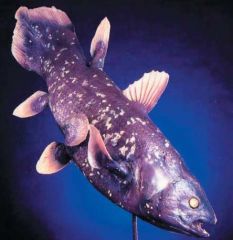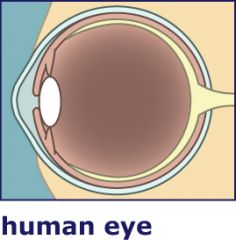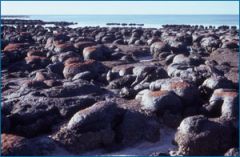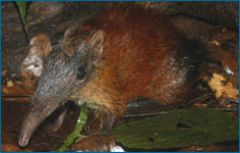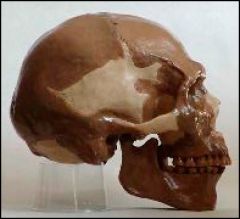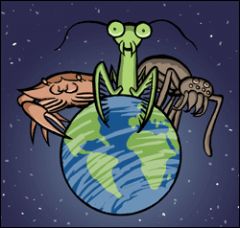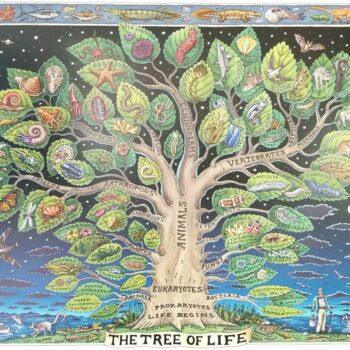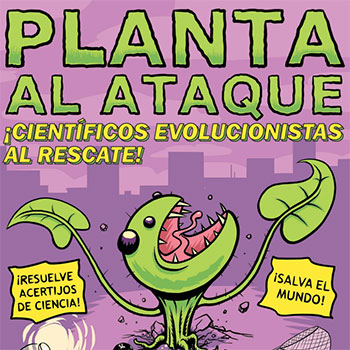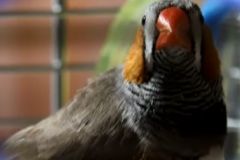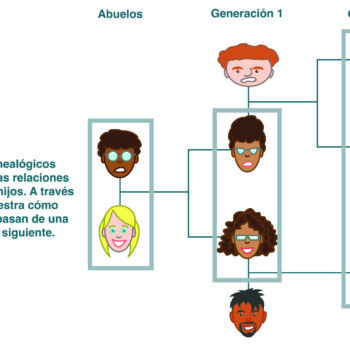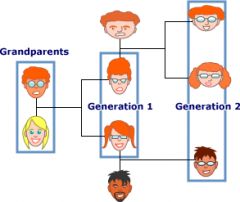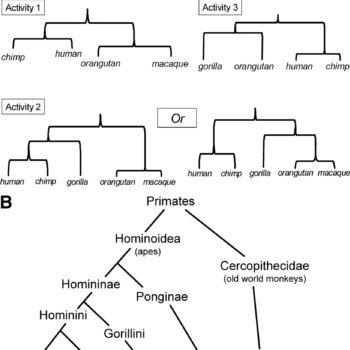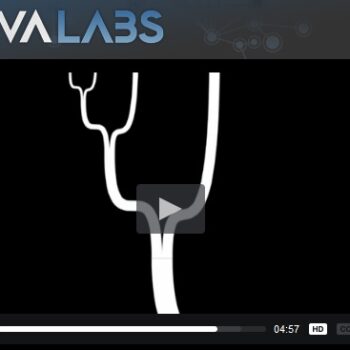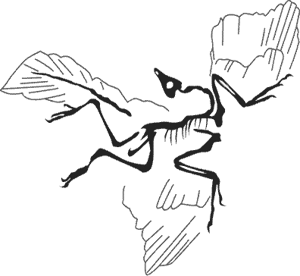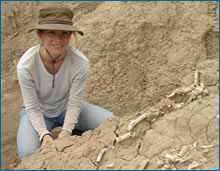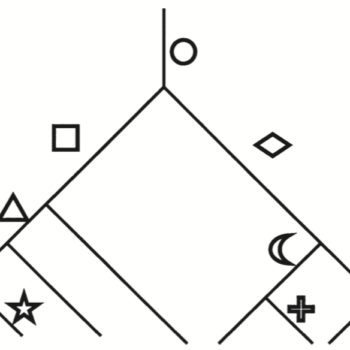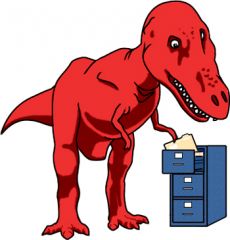Found 28 resources for the concept:
Similarities among existing organisms provide evidence for evolution. (LS4.A)
A Strange Fish Indeed: The “Discovery” of a Living Fossil
Grade Level(s):
- 9-12
- 13-16
Source:
- Grant, Robert
Resource type:
- Classroom activity
Time: 50-90 min.
Overview
Through a series of fictionalized diary entries, this case recounts the 1939 discovery by Marjorie Courtenay-Latimer (and identification by J.L.B. Smith) of a living coelacanth, a fish believed to have been extinct for 70 million years.
An Antipodal Mystery
Grade Level(s):
- 9-12
- 13-16
Source:
- Herreid, Clyde Freeman
Resource type:
- Classroom activity
Time: 1 to 2 hours, ideally split over multiple class periods
Overview
The discovery of the platypus had the scientific world in an uproar with its mammal-like and bird-like features. How was one to classify the platypus? This case study uses this issue to model the scientific process, with scientists arguing, debating, collecting more evidence, and revising their opinions as new data become available.
Bringing homologies into focus
Grade Level(s):
- 9-12
- Advanced
- General
Source:
- Evolution: Education and Outreach
Resource type:
- Article
Time: 30 minutes
Overview
There's more to homologies and analogies than the iconic examples (e.g., the tetrapod limb) found in every high school textbook. This article goes beyond the basics to explore the many evolutionary scenarios that result in homoplasies and the many levels at which homologies might occur.
This article appears at SpringerLink.
Del caldo primigenio a las células: El origen de la vida
Grade Level(s):
- 9-12
- Advanced
- General
Source:
- UC Museum of Paleontology
Resource type:
- Tutorial
Time: 20 minutes
Overview
Profundiza en los conocimientos actuales sobre el origen de la vida y en cómo los científicos y las científicas son capaces de investigar en los detalles de acontecimientos tan antiguos.
Evidencias de la Evolución: La ciencia de la evolución
Grade Level(s):
- 6-8
- 9-12
- General
Source:
- UC Museum of Paleontology
Resource type:
- Tutorial
Time: 30-40 minutes
Overview
Evo in the news: The new shrew that’s not
Grade Level(s):
- 9-12
- 13-16
- General
Source:
- UC Museum of Paleontology
Resource type:
- Evo in the News article
Time: 20 minutes
Overview
This news brief from March of 2008 describes scientists' discovery of a new mammal species, a giant elephant shrew. Though elephant shrews resemble regular shrews, recent genetic evidence suggests that elephant shrews actually sprang from a much older (and perhaps more charismatic) branch of the tree of life - the one belonging to elephants and their relatives.
Evolution of human skin color
Grade Level(s):
- 9-12
- 13-16
Source:
- Smithsonian National Museum of Natural History
Resource type:
- Classroom activity
Time: Seven to ten 50 minute class periods
Overview
Students examine evidence for the relationship between UV and melanin in other animals; investigate the genetic basis for constitutive skin color humans; learn to test for natural selection in mouse fur color; investigate how interactions between UV and skin color in humans can affect fitness; and explore data on migrations and gene frequency to show convergent evolution of skin color.
From soup to cells – The origin of life
Grade Level(s):
- 9-12
- Advanced
- General
Source:
- UC Museum of Paleontology
Resource type:
- Tutorial
Time: 20 minutes
Overview
Delve into our current understandings of the origins of life and how scientists are able to investigate the details of such ancient events.
This article is located within Evolution 101.
Hominid Cranium Comparison (The “Skulls” Lab)
Grade Level(s):
- 9-12
- 13-16
Source:
- ENSI
Resource type:
- Classroom activity
Time: One to two class periods
Overview
Students describe, measure and compare cranial casts from contemporary apes, modern humans, and fossil hominids to discover some of the similarities and differences between these forms and to see the pattern leading to modern humans.
How boogieing birds evolved: The work of Kim Bostwick
Grade Level(s):
- 9-12
- 13-16
- General
Source:
- UC Museum of Paleontology
Resource type:
- Research profile
Time: 30 minutes
Overview
This research profile follows ornithologist Kim Bostwick through the jungles of Ecuador and the halls of museums as she investigates the evolution of an exotic bird's complex mating dance.
Interactive investigation: The arthropod story
Grade Level(s):
- 6-8
- 9-12
- General
- Student
Source:
- UC Museum of Paleontology
Resource type:
- Online activity or lab
Time: 3-4 class periods
Overview
This interactive investigation delves into the amazing world of the arthropods and examines their success and their evolutionary constraints.
Investigating Common Descent: Formulating Explanations and Models
Grade Level(s):
- 9-12
- 13-16
Source:
- National Academy of Sciences
Resource type:
- Classroom activity
Time: Two class periods
Overview
Students formulate explanations and models that simulate structural and biochemical data as they investigate the misconception that humans evolved from apes.
Lines of evidence: The science of evolution
Grade Level(s):
- 6-8
- 9-12
- General
Source:
- UC Museum of Paleontology
Resource type:
- Tutorial
Time: 30-40 minutes
Overview
The theory of evolution is broadly accepted by scientists — and for good reason! Learn about the diverse and numerous lines of evidence that support the theory of evolution.
Modeling Evolutionary Relationships with Trees
Grade Level(s):
- 6-8
- 9-12
Source:
- Shape of Life
Resource type:
- Classroom activity
Time: 100-120 minutes
Overview
In this lesson, students will examine a beautiful tree of life poster by artist Ray Troll and use it as a launchpad to explore evolutionary, or phylogenetic trees. Students will take a pre-assessment to address misconceptions about phylogenetic trees before completing a modeling activity to give them a better understanding of how trees are used to model evolutionary relationships.
Plant on a Rampage
Grade Level(s):
- 6-8
- 9-12
Source:
- UC Museum of Paleontology
Resource type:
- Classroom activity
- Comic
Time: 50 minutes
Overview
In this printable comic/activity book, you'll meet scientists who use evolutionary ideas to solve medical problems. You'll also learn about evolutionary trees while you solve science puzzles and complete a craft.
Planta al ataque
Grade Level(s):
- 6-8
- 9-12
Source:
- UC Museum of Paleontology
Resource type:
- Classroom activity
- Comic
Time: 50 minutes
Overview
En este cómic/libro de actividades, conocerás a científicos que utilizan ideas evolutivas para resolver problemas médicos. También aprenderás sobre los árboles evolutivos mientras resuelves rompecabezas científicos y completas una actividad.
Predicting evolutionary relationships
Grade Level(s):
- 9-12
Source:
- NOVA
Resource type:
- Classroom activity
Time: 1 hour
Overview
Students compare the sequence of amino acids in a gene shared between humans and six other organisms and infer evolutionary relationships among the species.
Semejanzas y diferencias: Comprendamos las homologías y evolución convergente (nivel bachillerato)
Grade Level(s):
- 9-12
- General
- Student
Source:
- UC Museum of Paleontology
Resource type:
- Online activity or lab
Time: 30 minutes
Overview
Esta investigación interactiva explica qué son las homologías, cómo reconocerlas y cómo es que evolucionan.
Similarities and differences: Understanding homology and convergent evolution
Grade Level(s):
- 9-12
- General
- Student
Source:
- UC Museum of Paleontology
Resource type:
- Online activity or lab
Time: 30 minutes
Overview
This interactive investigation explains what homologies are, how to recognize them, and how convergent traits evolve.
Teaching the Process of Molecular Phylogeny and Systematics: A Multi-Part Inquiry-Based Exercise
Grade Level(s):
- 9-12
- 13-16
Source:
- Lents, Nathan, et al
Resource type:
- Lab activity
Time: 1 to 4 periods
Overview
Students explore molecular data from Homo sapiens and four related primates and develop hypotheses regarding the ancestry of these five species by analyzing DNA sequences, protein sequences, and chromosomal maps.
The Evolution Lab
Grade Level(s):
- 9-12
Source:
- NOVA Labs
Resource type:
- Lab activity
Time: 3 hours
Overview
The Evolution Lab contains two main parts. In the first, students build phylogenetic trees themed around the evidence of evolution, including fossils, biogeography, and similarities in DNA. In the second, students explore an interactive tree of life and trace the shared ancestry of numerous species.
The Evolution of Flight in Birds
Grade Level(s):
- 9-12
Source:
- UC Museum of Paleontology
Resource type:
- Online activity or lab
Overview
This interactive module examines evidence from the fossil record, behavior, biomechanics and cladistic analysis to interpret the sequence of events that led to flight in the dinosaur lineage.
The genes that lie beneath: The work of Leslea Hlusko
Grade Level(s):
- 9-12
- 13-16
- General
Source:
- UC Museum of Paleontology
Resource type:
- Research profile
Time: 40 minutes
Overview
Evolutionary biologist Leslea Hlusko's research takes her from the deserts of Ethiopia, where she hunts for hominid and primate fossils, to a baboon colony in San Antonio where she takes thousands of measurements of the primates' imposing canines. This research profile describes how the two projects are linked by a hunt for genetic variation, a key component of natural selection.
The great clade race: Zombie Edition
Grade Level(s):
- 9-12
- 13-16
Source:
- Martindale, Rowan and Goldsmith, David
Resource type:
- Classroom activity
Time: 30-50 minutes
Overview
This activity uses a simple puzzle to get students to use cladistic thinking without bogging them down with terminology.
Webcast: Fossils, genes, and embryos
Grade Level(s):
- 9-12
- 13-16
- Advanced
- General
Source:
- Howard Hughes Medical Institute
Resource type:
- Video Lecture
Time: 60 minutes
Overview
In lecture three of a four part series, evolutionary biologist David Kingsley examines the original objections to Darwin's theory and shows how modern evidence supports the theory.
This lecture is available from Howard Hughes' BioInteractive website.
Webcast: The science of evolution
Grade Level(s):
- 9-12
- General
Source:
- New York Times
Resource type:
- Video
Time: 10 minutes
Overview
Evolutionary biologist Sean Carroll introduces the field of Evo-Devo, using examples from fruit flies, butterflies, and icefish to explain how this research is transforming our understanding of evolution.
This video is available from the New York Times website.
What did T. Rex Taste Like?
Grade Level(s):
- 6-8
- 9-12
Source:
- UC Museum of Paleontology
Resource type:
- Online activity or lab
Time: 2-4 hours
Overview
In this web-based module students are introduced to cladistics, which organizes living things by common ancestry and evolutionary relationships.
What does it mean to be human?
Grade Level(s):
- 9-12
- 13-16
Source:
- Smithsonian National Museum of Natural History
Resource type:
- Classroom activity
Time: 8 x 50-minute class periods
Overview
In this set of advanced lessons, students use different types of data to infer/interpret phylogenies among domains, within the vertebrates, and within primates while reflecting on how they answer the question "What do you think it means to be human?" and choose a characteristic that changed substantially in the human family tree to develop a scientific argument based on evidence for when the character evolved.

